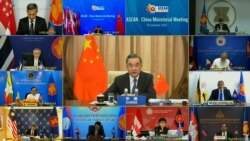Chinese authorities plan to position their first homegrown semi-submersible oil rig in a deep-water field in the disputed South China Sea to show rivals how far it’s willing to go for energy security and possibly to expand its political clout, observers believe.
The platform built over the past 21 months will begin work at the Lingshui 17-2 gas field 150 kilometers away from China, domestic media outlets said January 18. The site happens to be China’s first deep-water gas field in the sea, which is contested by five other governments.
While the proposed drilling site lies within China’s exclusive economic zone of 370 kilometers from its shorelines, Beijing's widespread reporting of the new platform shows the other claimants and rival superpower Washington how far it could go in securing fuel for domestic use, analysts say.
“I assume they’ll probably put it in contested waters and leave it there for a few days until whoever gets upset,” said Stephen Nagy, senior associate professor of politics and international studies at International Christian University in Tokyo.
“We really don’t know what they’re going to do, but I think it’s just further evidence of China staking a stronger claim in the South China Sea, pushback against the United States and other countries who are putting pressure on China or at least arguing that China doesn’t have sovereignty within the region,” he said.
Beijing claims about 90% of the South China Sea and cites historic usage records to back its position. China has used its technological and military superiority over the other claimants to develop islets in the sea, which stretches from its southern coasts to the island of Borneo. Rival claimants Brunei, Malaysia, the Philippines and Vietnam drill for oil and gas in the same 3.5 million-square-kilometer sea.
Vietnam’s claims come closest to the Chinese gas field and Hanoi is unlikely to protest if the rig stays on site without expanding, said Alexander Vuving, professor at the Daniel K. Inouye Asia-Pacific Center for Security Studies in Hawaii. But in 2014 a Chinese rig positioned in disputed waters touched off boat ramming and deadly anti-China riots in Vietnam. That sort of flap could pop up again, Vuving said.
“China’s assertiveness has become a new normal,” he said. “If China is really thinking in terms of calming the waters, then they would probably be a little more cautious, but of course China has been very assertive, even aggressive, since a decade now.”
The drilling platform operated by China National Offshore Oil weighs an “impressive” 50,000 tons, Chinese media outlet CGTN.com says.
State-run China Daily’s news website calls the creation the world’s heaviest deep-water semi-submersible oil production and storage platform. It has three “world-class” innovations and 13 “domestic advanced technologies”, the website said January 14.
Both news outlets publish in English to reach readers outside China.
Wording of that type suggests that China wants to impress on the world that the platform can help it get the fuel that it needs, said Aaron Rabena, research fellow at the Asia-Pacific Pathways to Progress Foundation in the Philippines. The world factory powerhouse depends on oil and gas for manufacturing.
“Maybe it’s just their way of showing they want to address their energy security [and] maximize their resources,” Rabena said.
A net oil importer since 1993, China aims to ease its “fear of strategic vulnerability” by looking abroad for fuel, developing natural gas and expanding refineries in the Middle East, the RAND Corp.-published book China’s Quest for Energy Security says.
The super-sized drilling setup might help China shine politically, too, as it pushes other countries to explore jointly for undersea fuel, analysts say.
Development of the homegrown platform could “stir up” discussions over joint oil and gas exploration in the South China Sea again, the Chinese state-controlled news outlet Global Times said in 2019.
Joint development with the other maritime claimants would help build political relations, scholars have said.
In 2018 China offered the Philippines 60% of any discoveries made in a disputed tract of sea. The Philippines is ready to “support companies of the two countries in joint oil and gas development”, the Chinese foreign ministry said on its website in October 2020.
Other countries, however, suspect that China would leverage any joint deals to scope out contested waters, Nagy said.
The South China Sea holds about 11 billion barrels of oil and 190 trillion cubic feet of natural gas, the U.S. Energy Information Administration estimates.








